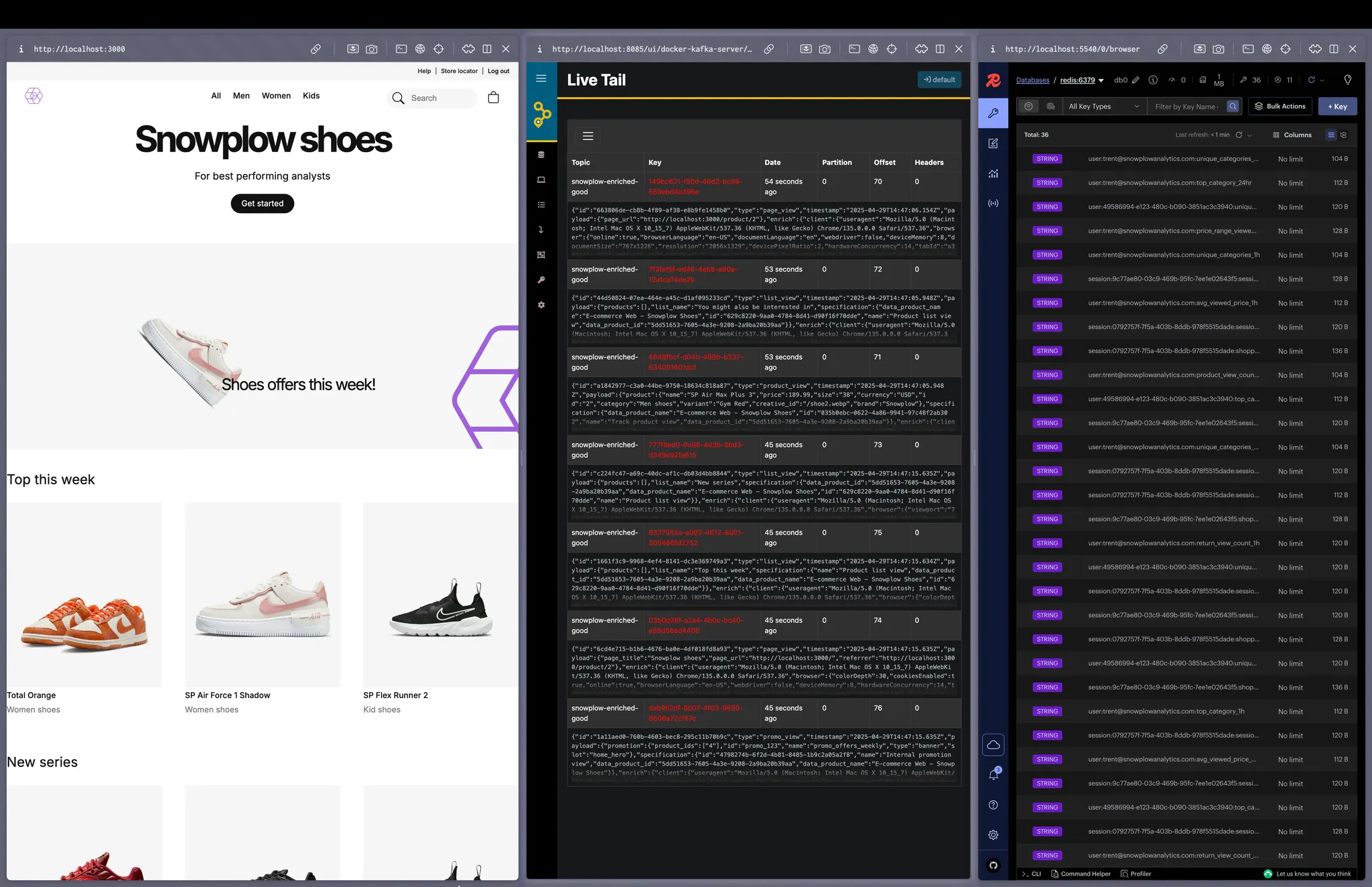Learn how to calculate real-time shopper features using Apache Flink
Welcome to the real-time shopper features using Apache Flink solution accelerator for ecommerce.
This accelerator demonstrates how to leverage Snowplow's behavioral data to monitor and act on shopper behavior while they're still navigating your site.
Traditional analytics stacks focus on deriving insights after the fact—business intelligence dashboards that show what happened. Real-time monitoring enables proactive actions such as initiating a live chat, or sending a unique discount code based on surges in shopper activity.
In this accelerator, you'll learn how to calculate key metrics, in near real time, that can power other systems.
After you set up the project, you can explore the system via three tools:
- Snowplow ecommerce store (left panel in below image)
- AKHQ, a Kafka visualization tool (center panel)
- Redis Insights, a Redis visualization tool (right panel)
All interactions on the store flow through Snowplow Local and are streamed into Kafka, where they are processed using Flink.

The computed metrics can also feed longer-term dashboards, enhancing the quality and reusability of your data.
Prerequisites#
This accelerator is fully Dockerized. The only prerequisites are Docker 28+ and Git.
Solution accelerator code#
The code for this accelerator is available on GitHub.
The project structure is:
apps/contains the Flink processing application (flink/) and the demo ecommerce store (ecommerce/)infra/contains Docker Compose configurations for the infrastructure components: Snowplow, Kafka, Redis, and Localstackdocker-compose.yamlis the main Docker Compose file including all servicesup.shis a convenience script to initialize and start all services
Key technologies#
- Snowplow: event tracking pipeline (Collector, Enrich, Kafka sink)
- Apache Flink: stream processing engine for real-time analytics
- Apache Kafka: message broker for decoupling event producers and consumers
- Redis: in-memory data store for storing computed metrics
- Next.js: framework for the demo ecommerce application
- Docker and Docker Compose: containerization for easy setup and deployment of all services
- AKHQ: web UI for Kafka management and inspection
- Redis Insight: web UI for Redis data visualization and management
- Grafana: visualization tool for monitoring and analyzing metrics
Architecture#
This diagram shows the architectural overview:
Benefits of this architecture:
- Sub-second freshness: metrics are computed in the stream, not via nightly batch jobs, so they're actionable in-session
- Single source of truth: the same logic powers dashboards and in-session nudges
- Composable and portable: the entire system runs in Docker, and can be adapted to cloud-managed Kafka/Flink/Redis with minimal changes
The key subsystems are described below.
Event capture and ingestion with Snowplow#
- E-store front-end and Snowplow JavaScript tracker: user activity is captured as Snowplow ecommerce events
- Snowplow Local to Kafka: the Snowplow pipeline validates the events, enriches them with device and geolocation data, then forwards them into Kafka
Real-time stream processing in Flink#
- Source: a single Flink job reads from the
enriched-goodtopic - Branching by event type: the stream is split into four logical lanes (product, category, cart, purchase)
- There are two options for keying and windowing:
- Rolling windows (5 min, 1 h, 24 h): keyed by
user_idfor always-fresh "last-N-minutes" stats - Session windows: keyed by
session_id, grouping events into sessions that end after 30 minutes of inactivity
- Rolling windows (5 min, 1 h, 24 h): keyed by
- Aggregations: each lane computes its own features e.g. view counts, average price, cart value, session duration
- Metric parsers: convert aggregated values into one or more metrics, e.g. a unique product count may feed both product view metrics and average viewed price metrics
Feature store and action loop#
- Sink to Redis: Flink writes each metric to Redis using deterministic keys like
user:{id}:{feature}_{window}orsession:{sid}:{metric}, making Redis a low-latency feature store - Backend consumers: the ecommerce store back-end (or any downstream app like ML models or dashboards) can retrieve metrics in microseconds to:
- Trigger live-chat prompts when high-value carts stall
- Send discounts based on price sensitivity
- Feed both real-time dashboards and long-term analytics using consistent definitions
Acknowledgements#
Thank you to the Data Streaming experts evoura for their support with building this accelerator.
